
The lagomorphs are the members of the taxonomic order Lagomorpha, of which there are two living families: the Leporidae and the Ochotonidae (pikas). The name of the order is derived from the Ancient Greek lagos + morphē. There are 110 recent species of lagomorph of which 109 are extant, including 34 species of pika, 42 species of rabbit, and 33 species of hare.
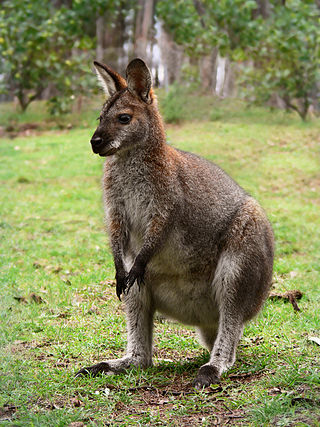
A wallaby is a small or middle-sized macropod native to Australia and New Guinea, with introduced populations in New Zealand, Hawaii, the United Kingdom and other countries. They belong to the same taxonomic family as kangaroos and sometimes the same genus, but kangaroos are specifically categorised into the four largest species of the family. The term "wallaby" is an informal designation generally used for any macropod that is smaller than a kangaroo or a wallaroo that has not been designated otherwise.

Leporidae is the family of rabbits and hares, containing over 70 species of extant mammals in all. The Latin word Leporidae means "those that resemble lepus" (hare). Together with the pikas, the Leporidae constitute the mammalian order Lagomorpha. Leporidae differ from pikas in that they have short, furry tails and elongated ears and hind legs.

The Lacertidae are the family of the wall lizards, true lizards, or sometimes simply lacertas, which are native to Afro-Eurasia. It is a diverse family with at about 360 species in 39 genera. They represent the dominant group of reptiles found in Europe.
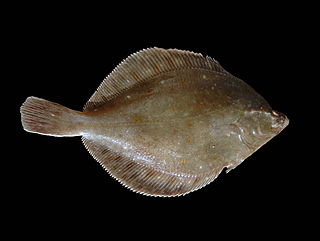
Pleuronectidae, also known as righteye flounders, are a family of flounders. They are called "righteye flounders" because most species lie on the sea bottom on their left sides, with both eyes on their right sides. The Paralichthyidae are the opposite, with their eyes on the left side. A small number of species in Pleuronectidae can also have their eyes on the left side, notably the members of the genus Platichthys.

Dirachma is the sole genus of the family Dirachmaceae. The genus had been monotypic, its sole species being the woody plant Dirachma socotrana, until a second, herbaceous, species, Dirachma somalensis, was discovered in Somalia and described in 1991.
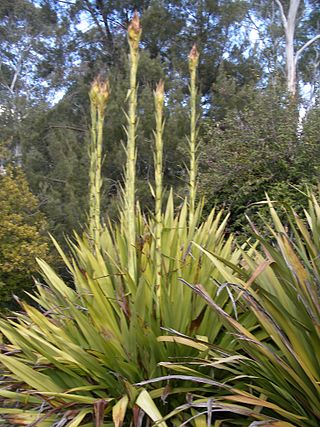
Doryanthes is the sole genus in the flowering plant family Doryanthaceae. The genus consists of two species, D. excelsa and D. palmeri, both endemic natives of the coast of Eastern Australia. Doryanthaceae is part of the order Asparagales.
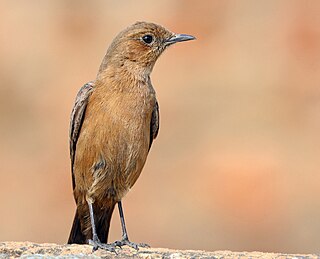
The brown rock chat or Indian chat is a bird species of the family Muscicapidae. It is found mainly in northern and central India. It is often found on old buildings and rocky areas. It resembles a female Indian robin but lacks the reddish vent and differs in posture and behaviour apart from being larger. In flight it bears some resemblance to thrushes and redstarts. It feeds on insects, captured mainly on the ground. It was formerly placed as the sole species in the genus Cercomela but is now included with the wheatears in the genus Oenanthe.

Chlorokybus is a multicellular (sarcinoid) genus of basal green algae or charophyte. It has been classified as the sole member of the family Chlorokybaceae, which is the sole member of the order Chlorokybales, in turn the sole member of the class Chlorokybophyceae. It grows on soil and rock surfaces, and is rare.
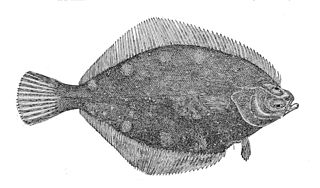
The rock sole, also known as the Pacific rock sole or Southern rock sole is a flatfish of the family Pleuronectidae. It is a demersal fish that lives on sand and gravel bottoms at depths of up to 575 metres (1,886 ft), though it is most commonly found between 0 and 183 metres. Its native habitat is the temperate waters of the northern Pacific, from Baja California to Alaska, the Aleutian Islands and southeastern parts of the Bering Sea. It grows up to 60 centimetres (24 in) in length and can weigh up to 1.8 kilograms (4.0 lb), and has a maximum recorded lifespan of 22 years.
The northern rock sole is a flatfish of the family Pleuronectidae. It is a demersal fish that lives on sand, mud and gravel bottoms at depths of up to 700 metres (2,300 ft), though it is most commonly found between 19 and 246 metres. Its native habitat is the temperate waters of the northern Pacific, from Puget Sound to Alaska, the Aleutian Islands and across the Bering Sea to the Kuril Islands and the Sea of Okhotsk. Males grow up to 69 centimetres (27 in) in length, whilst females can reach 49 centimetres (19 in). The maximum recorded lifespan is 18 years.

The Scombrinae are a subfamily of ray-finned bony fishes in the family Scombridae. Of the 51 species in the Scombridae, 50 are in Scombrinae – with the sole exception being the butterfly kingfish, which is placed in the monospecific subfamily Gasterochismatinae.

Achirus is a genus of American soles native to tropical and subtropical parts of the Americas. They are mainly found in coastal areas, including salt and brackish water, but some species are found in fresh water.
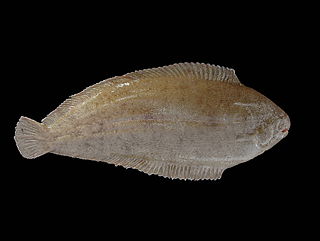
Solea is a genus of soles from the Indo-Pacific and East Atlantic Oceans, and the Mediterranean Sea.
Manjekia is a monotypic genus of palm for a species of palm native to Biak island, Indonesia, off the northwest coast of New Guinea. The genus was proposed in 2014.
Cifelliodon is an extinct genus of mammaliaforms from the Lower Cretaceous of North America. In the describing paper, it was considered one of the latest surviving haramiyids yet known, belonging to the family Hahnodontidae. Its discovery led to the proposal to remove hahnodontids from the larger well-known group, the multituberculates. However, later papers have considered it to be a basal allotherian outside of Haramiyida.

Hermatobates is a genus of wingless marine bugs placed as the sole genus in the family Hermatobatidae that are sometimes known as coral-treaders. They are quite rare and known only from coral reefs in the Indo-Pacific region. During low tide, they move over the water surface not unlike the more familiar water-striders around coral atolls and reefs and stay submerged in reef crevices during high tide.














